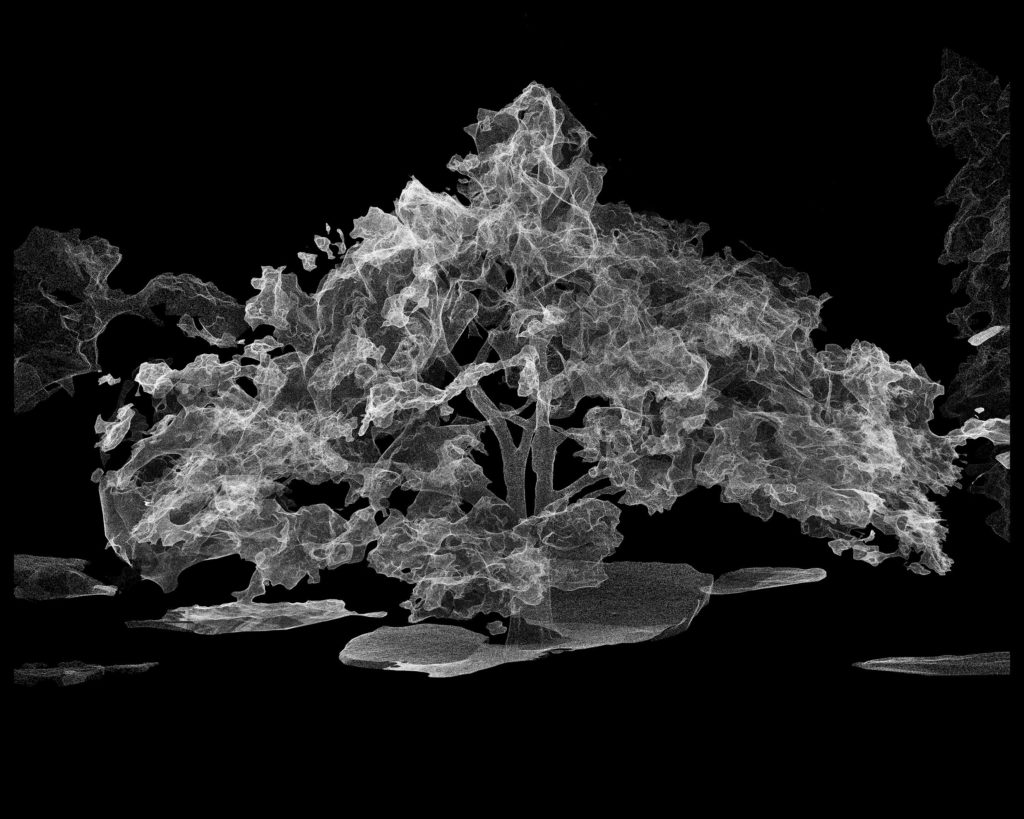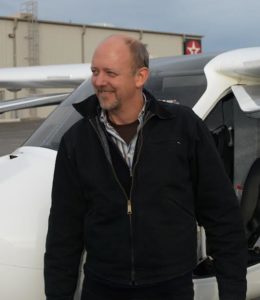- About Us
- Our Work
- Tree Info
- Get Involved
- Blog
- Support Us
By Canopy Team on June 30, 2017

Artist: Michael Light. “The Rinconada Oak” Seen as a Drone-Captured Point Cloud, Palo Alto Heritage Tree #2, 75’ Tall, 120’ Wide and 200 Years Old, Palo Alto, California, Pigment print 40" x 50", 2017
This summer from June 17th to August 27th, the Palo Alto Art Center is hosting a new exhibit, Planetary Landscape, with San Francisco based photographer Michael Light. Canopy is especially excited about this project because it captures one of Palo Alto’s iconic oak trees—a Coast Live Oak in Rinconada Park—from a whole new perspective.
The Planetary Landscape exhibit follows the theme of “human intervention in natural processes.” It features images taken by Michael using traditional visual arts tools as well as digital technologies like an aerial drone camera.
In celebration of the opening exhibit we met up with Michael to learn more about his unique approach to photography and what drew him to the Rinconada oak tree as a subject for this exhibit.
Canopy: Many of your images are captured with tools and methods that go beyond what many of us think of as photography. Can you tell us a bit about your unique approach and methods? What led you to these techniques?
Michael: Most of my work employs or examines photography in fairly standard ways, but perhaps what is different is that I’ve always been interested in how we use cameras as prosthetic extensions of our eyes, to extend vision where it otherwise could never biologically go: outer space, under water, above the ground looking down, close to the surfaces of a created thermonuclear star that would otherwise vaporize sight as well as the rest of our bodies.
You note that human intervention in natural processes is a major theme in your work. What compels you to explore this theme? How do you hope your work will influence viewers?
One could simply title all of my work, done over many years and in varied idioms, “What We Do.” It’s of interest to me because the human species has become the largest and most influential life form on the planet, to the detriment of animate things and even itself. As far as I’m concerned, examining human power and ambition amidst the structures of everything non-human on the planet is unavoidable as a subject. One can’t seriously examine the unbuilt world without looking at all the changes we’ve wrought — and in this moment in time our own manipulations outweigh the power of non-human forces. As a species we deliberately move more dirt each year than does erosive rainwater. We have become our own geology.
“The human species has become the largest and most influential life form on the planet…We have become our own geology.
What gave you the idea for the Rinconada Oak images?
I was generously given a broad commission to do anything I wanted by the Palo Alto Art Center in connection with its 45th anniversary, and it was clear to me that somehow I wanted to work locally, to think about what Palo Alto is as a place and a force, in both literal and metaphorical terms.
As a place of course it’s defined by its trees, right down to its name, and this past Spring was especially vibrant and green after so many years of drought — anthropomorphically, it seemed that the trees were beyond “delighted,” and it was clear that they would be my immediate subject because they are physically the most important player in town.
They are also far and away the oldest and most patient living things in the region. But the other most important force at play in the community has no body, no form, and no place. Countless digital technologies are spawned and nurtured in Palo Alto, from whence they inexorably move outward across the globe across all cultures and geographies disrupting everything in their path. The speed of the radiating transformations is extreme, the half-life of its softwares very short, and the patience of their creators famously short. I felt that the trees of Palo Alto are the perfect philosophical and metaphorical counterbalance to what else the city is known for.
“El Palo Alto,” the city’s iconic namesake redwood, is difficult to image because it sits closely amidst several siblings in a grove, so I went to the second most venerated tree in the city, the 200 year old, 75 foot high, 120 foot wide tree named the “Rinconada Oak.”
How did you create the visualizations? What do they mean to you?
I used a drone to image this very large, very grand elder from every direction and height — there was distance enough from other trees in Rinconada Park — and then fed 800-odd overlapping photographs into complex three dimensional visualization software that created about 80 million separate points that represented the tree, both its exterior and its extrapolated interior.
I wonder what Palo Alto’s trees think of the busy little homo sapiens all around them, pursuing their urgent global transformations.
None of these points, which together create a high resolution image of the tree that one can “fly” through in all directions, represents visible reflected light on a surface the way we normally interpret a photograph, but is closer to a kind of x-ray seeing.
The point cloud is completely the product of mechanical vision — drones and software and computers — with just a few parameters set by the human operator. I find the newness of the seeing contrasted with the age and grace of the tree itself to be fertile territory anyway, but particularly so in Palo Alto.
You mention in your description of this piece that you chose these “two-dimensional cross sections” out of tens of thousands of possibilities generated from your drone images. What drew you to the two images you selected for the exhibit?
I felt I needed a “representational,” recognizable image of the oak itself to place the viewer, and then for the second image allowed myself a deeper level of abstraction, where boundaries between inside and outside and up and down are bypassed. In the second image one is effectively inside the structure of the tree itself looking out at the world. I wonder what Palo Alto’s trees think of the busy little homo sapiens all around them, pursuing their urgent global transformations.
The ethereal look of the image really sparks our imagination. Do you find that you “see” an object differently after you photograph it?
Everything I work with photographically as an artist transforms the way I see it — that’s the reason I want to work with imagery in the first place. It’s the way I attempt to understand and explore the world, on a deeper level than words or read knowledge or often even physically-lived experience. I’m not always successful, but when I get that perfect image I can deepen my understanding profoundly and lastingly. My process allows me to stare.
Do you have any plans for these images after this exhibit?
I’d like to keep working in Palo Alto and image further key sentinels watching over particularly resonant hot spots in town: what are SLAC’s greatest trees, for example? What’s the tree, say, that Elon Musk looks out upon from his office, or the arboreal view of some of the more famous venture capital desks on Sand Hill Road?

Artist Michael Light
Exhibit Details:
Gallery: Palo Alto Art Center
Artist: Michael Light
Exhibit: Planetary Landscape
Curator: Sharon Bliss
Exhibit Dates: June 17th to August 27th
Oak Resources:
Rinconada Tree Walk
Tree Library: Coast Live Oak
How to Care for Native Oaks